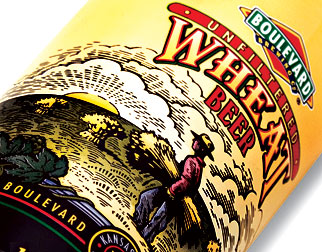
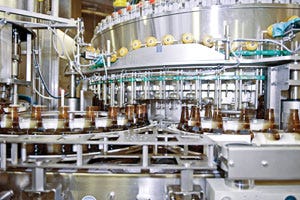
Boulevard Brewing
Founded in 1989, Boulevard Brewing, Kansas City, MO, has grown to be the largest craft brewer in the Midwest, with a capacity of 140,000 barrels in 2009. The company completed a new brewhouse facility in 2006 and installed a state-of-the-art, $6-million bottling line in 2008.“Our intent for the new line was to work more efficiently, improve quality and possess the flexibility needed for future projects like the new aluminum bottles,” says Jeremy Ragonese, director of marketing.
The company produces a variety of craft beers, but its specialty is unfiltered wheat beer, which, along with its flagship offering, pale ale, comprises more than 80 percent of Boulevard's sales. Boulevard runs its new 16-oz aluminum bottles of unfiltered wheat beer (see the accompanying sidebar), which it introduced in 2009, as well as its other brews in its longstanding Heritage glass bottles and its relatively new longneck glass bottles on the new line.
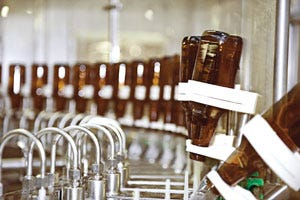
Boulevard brewing
Boulevard employs a time-honored technique known as bottle conditioning to help its beers taste fresher, better, longer. Once it has brewed, fermented and filtered the beer as usual, Boulevard then adds a small amount of yeast to the beer just before bottling. The packaged beer is then transferred to a temperature-controlled warehouse, where it is held for two weeks to allow a secondary fermentation to take place in the bottle.
Boulevard brewing
This secondary fermentation consumes much of the residual oxygen, greatly enhancing the stability and longevity of the beer and producing a depth of flavor.Heritage bottles
During PD's visit, the plant was running its Heritage bottles. Some of the photos in this story were taken previously, and show the aluminum bottles that also run on this line.
Sentry Equipment Inc. was the system integrator for the line and designed the two-floor line layout. It supplied all of the conveyors in the system. As you will note from viewing the accompanying floor plans, Sentry designed an extensive conveyor system to provide bulk transport and accumulation between machines as well as single-filing the bottles when necessary. The bulk conveyors provided enough bottle accumulation that separate accumulation equipment was not required.
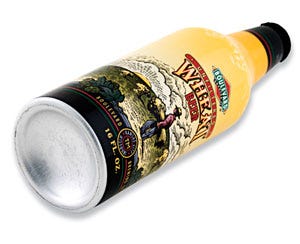
Boulevard brewing
The bottles, which are received stacked eight-layers high on pallets, are depalletized, one layer at a time, by a machine from Sentry. The glass bottles are supplied by Saint Gobain and the aluminum bottles are supplied by Exal Corp. A pallet of bottles is placed on the infeed conveyor and moved into the depalletizing zone. Once the pallet is in the static position, each layer is removed by the robotic carriage and placed at the bottle-conveyor level, where the swing arm removes the tier sheet. The carriage then pushes the bottles onto the accumulation table conveyor.The bottles are single-filed and then enter a lowerator in which Neoprene grippers hold them in an upright position as they travel around a vertical curve and are carried upward to the second floor, where they go around another vertical curve and are transferred to a horizontal table-top conveyor. At this point, a Videojet Technologies Excel 2000 Opaque ink-jet printer applies a code date to the shoulders of the bottles.
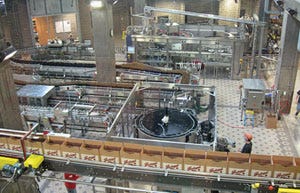
Boulevard brewing
Monobloc rinser/filler/crowner

Boulevard brewing
The bottles then enter a monobloc system from Krones consisting of a 60-valve Variojet rinser for treating the nonreturnable bottles, a 78-valve Mecafill VKPV counter-pressure filler and a 13-head crowner. Bottles are transferred into the rinser by a screw and infeed starwheel where plastic clamps developed especially for the rinser firmly hold the bottles at the bottle neck and the body.
As the turret rotates, the containers are swung upwards through 180deg, after which spraying nozzles positioned directly underneath the neck finish injecting the rinsing medium into the bottles. The bottles are then returned to the upright position and are transferred through the discharge starwheel onto the conveyor. A screw mounted beside the conveyor maintains the precise spacing of the bottles as they travel to the filler, where they enter through another infeed starwheel.
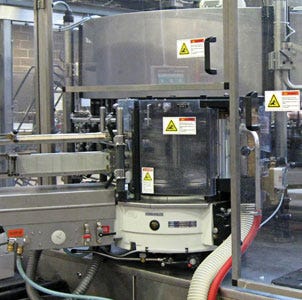
Boulevard brewing

Boulevard brewing
With the new Krones bottling line, the brewery revamped its technology. Before being fed to the bottling line, the beer is warmed up in a flash pasteurizer, yeast and sugar are added in the pipe to the filler, and the beer is filled warm at about 68 deg F. This warm-filling produces a higher carbon-dioxide content, post-fermentation begins earlier and the duration of in-bottle fermentation is thus shortened by two to three days.
The Krones Mecafill is an electro-pneumatic filling system that integrates a vacuum feature that enables double pre-evacuation of the bottles, thus assuring low oxygen pickup during the beerbottling operation. As a bottle enters the rotating turret, the pneumatic lifting cylinder presses it onto the filling valve until a gas-tight seal is formed.
This connects the bottle to the ring bowl. In this position, the gas needle and the product stem in the filling valve are closed. Following an electronic pulse, the vacuum valve opens and draws a vacuum that reduces the percentage of air in the bottle to about 10 percent.
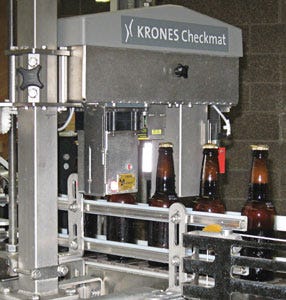
Boulevard brewing
The pneumatically controlled gas needle then opens the connection to the ring bowl and carbon dioxide flows into the bottle, after which the pneumatically-controlled vacuum valve opens again, producing another vacuum within the bottle. This reduces the air concentration in the bottle to approximately 1 percent.The gas needle then opens and admits the gas mixture from the ring bowl, through the vent tube, into the bottle. As soon as the pressures in the bottle and the ring bowl are equal, the product stem opens and filling begins. The product flows along the vent tube into the bottle, and a small spreader mounted on the vent tube guides the liquid to the bottle's inner sidewall, thus ensuring a gentle product flow.
After a short settling phase, the snifting valve opens the connection to the clean-in-place channel which allows the pressure in the bottle to equalize with the outside atmospheric pressure, after which the bottle is lowered and transferred to the discharge starwheel.
The Mecafill VKP filler can be cleaned-in-place by placing cups on the lifting unit so they are pressed onto the filling valves. This results in a closed circuit through which the cleaning solution can flow into the ring bowl, the centering bell and through the open snifting and vacuum valves.
Bottles leaving the filler travel onto an infeed starwheel that delivers them into the crowner. Crowns are dumped into a floor hopper, travel up a magnetic elevator to an overhead sorter/feeder. The crowns then travel down a chute to a transfer plate where they are precisely centered on the mouth of the bottle. A bottleneck centering system for the bottles entering the crowner ensures that even bottles with inaccurate dimensions are reliably sealed. The crowns are positioned on the crowning head, which lowers as the crowner rotates, until the closing ring presses it onto the bottle mouth. When the crown is secured, the lifting cam raises the crowning head, and the bottle discharges from the machine through a starwheel.
The bottles travel through a Krones Checkmat inspection system to check fill levels before being conveyed to a Krones Topmatic cold-glue labeler with 36 bottle plates. This is one of the areas where Boulevard uses a long, serpentine conveyor to provide accumulation capacity. The conveyor is initially a bulk configuration, but it narrows down to single file as it nears the labeler. The bottles travel through a drier just ahead of the labeler to augment label adhesion.
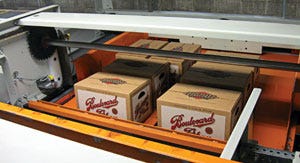
Boulevard brewing
Three-station labeler

Boulevard brewing
A feedscrew maintains bottle separation and meters the bottles into the labeler's infeed starwheel, which, in turn, transfers the containers to the revolving container table, where a centering bell descends to hold the bottle in place as the label is applied. The unit is equipped with three labeling stations to apply front, back and neck labels. The rubber-coated glue pallet in each labeling station is given a very thin film of glue from a gluing roller made of hardened steel.
The pallet picks up a label from a magazine, applies a film of glue to the label and then transfers the label to the gripper cylinder, which places the label precisely on a container as it passes by on the container table. The label is held in place on the container while being smoothed out with a brush and sponged roller. The labeled containers travel through a discharge starwheel onto the conveyor. The Topmatic lableler can be equipped with up to four labeling stations, each capable of attaching two or more labels. The labels are supplied by Mainline Printing.
After traveling another serpentine route, the bottles enter a Model Versatron case packer from Standard-Knapp. The bottles enter the case packer in bulk and oscillators direct them into lanes separated by lane guides. The bottles then move onto a dead plate, where they are stopped and timed by overhead brakes, which release each group of bottles onto riding strips. When the riding strips are full and a case is in place, sensors shift the riding strips, allowing the bottles to funnel down through grid fingers and drop into a case. To minimize bottle shock as the bottles drop into the cases, a two-axis servo system allows the Versatron to actually catch the product as it descends into the case. The lift table moves the case to the up position and waits for a full grid.
When the grid is full and the riding strips shift to the side and initiate the bottle descent, the lift table simultaneously moves the case downward on a velocity curve that ultimately achieves the same speed as the bottles at the point of contact.
Cases and cartons, which are supplied by Pratt Industries, are formed on a CE70 erector from Pearson Packaging Systems. Boulevard has two of these units. Starting with corrugated blanks that are stacked on edge on the horizontal bed of the high-capacity magazine, the CE70 automatically erects and bottom seals the cases. Vacuum cups that are mounted on a traveling arm pull a blank from the magazine, rotate it 90 deg and place it into the flight lugs. It is then transferred past the flap plow, prefolding the case's bottom minor and major flaps.
A caliper-equipped pickuparm grips the major flaps and erects the case with the minor flaps prefolded. The erected case is then transferred through the glue section to the sealing section where opposing mandrels positively seal the flaps. The sealed case is discharged through an uprighting chute and dropped onto a conveyor that delivers it to the packer.
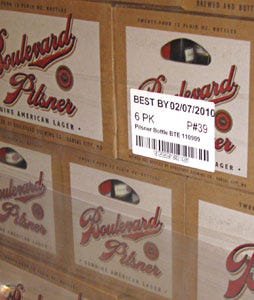
Boulevard brewing
Filled cases leaving the packer travel to Pearson Model CS40G case sealers that use hotmelt glue. Boulevard runs two of these units in parallel to keep up with production. Minor flaps are folded, a Nordson Corp. adhesive melter applies glue to the case and then the major flaps are folded, closing the case and compressing the top to ensure secure closure. Two Linx ink-jet coders from Diagraph, an ITW, one after each case sealer, apply lot codes to the tops of the cases leaving the case sealers.The cases then travel to a Standard-Knapp Traymore tray former/packer that places them in trays. Boulevard produces six- and 12-pack cases as well as a 24-bottle loose pack, and these are all packed into trays. A Diagraph IJ 3000 large-character ink-jet printer applies lot codes to the trays as they leave the packer.
The cases and trays travel up a powered spiral conveyor from Ryson and discharge onto a horizontal conveyor running just beneath the ceiling that carries them to the other side of the room. There, they discharge onto a spiral conveyor that carries them down to a conveyor running just beneath the ceiling of the first floor.
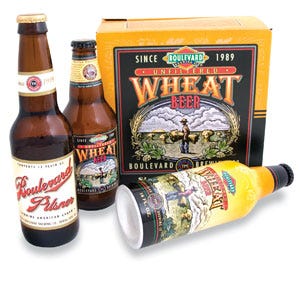
Boulevard brewing
Palletizing and stretch wrapping

Boulevard brewing
The cartons are conveyed to the high-level infeed of an Alvey A-780 palletizer from Intelligrated. After each layer of cases is placed on the pallet, the pallet lowers one layer. When the pallet is filled, it discharges from the machine at floor level. Particularly suited for single-line applications in the food and consumer goods industries, the A-780 utilizes high-level infeed and right-angle pattern formation to achieve outstanding pattern flexibility.
Pallet loads of product travel directly to a Lantech Q Series semi-automatic turntable stretch wrapper. In this operation, a roll of film is mounted on a tower. The operator attaches the free end of the film to the pallet and then triggers the operation.
The turntable rotates and pulls the film off of the roll, which moves up and down on the tower to completely encase the pallet in film. When the proper amount of film has been applied, the system stops, and the operator cuts the film and attaches the end to the pallet. As the pallet leaves the shrink wrapper, a Diagraph PA4600 labeling system prints and applies a label to the load.
“Clearly, it's been a substantial upgrade for our brewery,” says Steve Mills, chief operations officer, Boulevard Brewing Co. “Our bottling line plays an integral role in delivering a beer that betters industry standards, and the gains in efficiency and flexibility will continue to pay dividends for years to come.”
More information is available: |
Diagraph, an ITW Co., 800/722-1125. www.diagraph.com. |
Exal Corp., 330/744-2267. www.exal.com. |
Intelligrated Inc., 513/701-7300. www.intelligrated.com. |
Krones, Inc., 414/409-4000. www.kronesusa.com. |
Lantech, 502/267-4200. www.Lantech.com. |
Mainline Printing, 785/233-2338. www.mainlineprinting.com. |
Nordson Corp., 770/497-3700. www.nordsen.cocm. |
Pearson Packaging Systems, 800/732-7766. www.pearsonpkg.com. |
Pratt Industries, 770/918-5678. www.prattindustries.com. |
Ryson Intl. Inc., 757/898-1530. www.ryson.com. |
Sentry Equipment Inc., 434-525-0769. www.sentryequipment.com. |
Standard-Knapp Inc., 860/342-1100. www.standard-knapp.com. |
Saint Gobain Containers Inc., 765/741-7000. www.sgcontainers.com. |
Videojet Technologies Inc., 800/843-3610. www.videojet.com. |
About the Author(s)
You May Also Like


